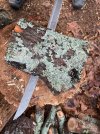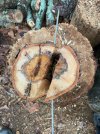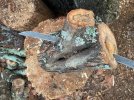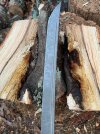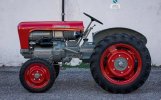I’ve used a modified FR28 with a reduced edge angle to chop pig trotters and large pig bones. Since the FR28 is also made of 3V steel, and even after the modification the edge angle remained quite large (around 45 degrees) with a thick bevel behind the edge, it was able to chop bones and coconuts without any edge damage. Now I'm curious whether the thinner V-ground edge on the K20 can also handle bone chopping without damaging the edge.I’d appreciate it if anyone with real-world experience could share their insights. Thanks!
-
The BladeForums.com 2024 Traditional Knife is available! Price is $250 ea (shipped within CONUS).
Order here: https://www.bladeforums.com/help/2024-traditional/
You are using an out of date browser. It may not display this or other websites correctly.
You should upgrade or use an alternative browser.
You should upgrade or use an alternative browser.
Can the CPK K20, when used with proper chopping angles, chop through large pig bones without chipping, rolling, or developing a white line on the edge
- Thread starter 未知艺术家
- Start date
on_the_edge
Gold Member
- Joined
- Jan 31, 2006
- Messages
- 11,746
Why don't you try it yourself?I’ve used a modified FR28 with a reduced edge angle to chop pig trotters and large pig bones. Since the FR28 is also made of 3V steel, and even after the modification the edge angle remained quite large (around 45 degrees) with a thick bevel behind the edge, it was able to chop bones and coconuts without any edge damage. Now I'm curious whether the thinner V-ground edge on the K20 can also handle bone chopping without damaging the edge.I’d appreciate it if anyone with real-world experience could share their insights. Thanks!
- Joined
- May 1, 2010
- Messages
- 5,112
I don't think they own a K20.Why don't you try it yourself?
DrBC
Gold Member
- Joined
- Feb 19, 2022
- Messages
- 501
I haven't used a K20 on bone before, but did abuse the hell out of one when I first got it. It was battoned through a gnarly Y shaped knot/log without any damage to the blade or edge. Also don't use a K20 like shown, this was excessively stupidNow I'm curious whether the thinner V-ground edge on the K20 can also handle bone chopping without damaging the edge. I’d appreciate it if anyone with real-world experience could share their insights. Thanks!
 But I would wager it would glide through a coconut with no problem. My guess is, it would take a very thick/dense bone to slightly damaging the edge, and even then, probably not much.
But I would wager it would glide through a coconut with no problem. My guess is, it would take a very thick/dense bone to slightly damaging the edge, and even then, probably not much.I've hit a rock embedded in a tree with a behemoth before while using a full swing and it only caused a tiny chip that didn't go even half way up the edge bevel. I've also hit some very large bolts directly head on at funky angles (by accident) with my K18, again with no damage that went above the edge bevel.
don’t know how long it will take for it to be available in my country. If I had it, I would definitely try it myself instead of asking you.Why don't you try it yourself?
如果有人带着猪骨头和椰子来到 Outlaw Cut 并让我使用他们的 K20,那我就是你的哈克贝利。
我以前没用K20砍过骨头,但刚拿到的时候确实狠狠地用了一把。它砍断了一个粗糙的Y形木节/木头,刀刃和刀刃都毫发无损。另外,千万别像图中这样用K20,这太蠢了。:竖起大拇指: 不过我敢打赌,它砍断椰子应该没问题。我猜,只有非常厚/密的骨头才会对刀刃造成轻微的损伤,即使这样,可能也不会太严重。
我以前用一把巨型斧子全力挥动,击中了嵌在树上的一块石头,结果只留下了很小的缺口,甚至不到刀刃斜面一半的高度。我还用我的K18以奇怪的角度(不小心)直接击中了一些非常大的螺栓,同样没有造成超过刀刃斜面的损坏。
我以前没用K20砍过骨头,但刚拿到的时候确实狠狠地用了一把。它砍断了一个粗糙的Y形木节/木头,刀刃和刀刃都毫发无损。另外,千万别像图中这样用K20,这太蠢了。:竖起大拇指: 不过我敢打赌,它砍断椰子应该没问题。我猜,只有非常厚/密的骨头才会对刀刃造成轻微的损伤,即使这样,可能也不会太严重。
我以前用一把巨型斧子全力挥动,击中了嵌在树上的一块石头,结果只留下了很小的缺口,甚至不到刀刃斜面一半的高度。我还用我的K18以奇怪的角度(不小心)直接击中了一些非常大的螺栓,同样没有造成超过刀刃斜面的损坏。
View attachment 2923117 View attachment 2923118 View attachment 2923119
我以前用一把庞然大物全力挥动时击中了一块嵌在树上的石头,只造成了很小的缺口,甚至没有达到刀刃斜面的一半。我还用我的 K18 以奇怪的角度(意外)直接击中了一些非常大的螺栓,同样没有超过刀刃斜面的损坏。
Your reply was very helpful to me. Thank you so much!I haven't used a K20 on bone before, but did abuse the hell out of one when I first got it. It was battoned through a gnarly Y shaped knot/log without any damage to the blade or edge. Also don't use a K20 like shown, this was excessively stupidBut I would wager it would glide through a coconut with no problem. My guess is, it would take a very thick/dense bone to slightly damaging the edge, and even then, probably not much.
I've hit a rock embedded in a tree with a behemoth before while using a full swing and it only caused a tiny chip that didn't go even half way up the edge bevel. I've also hit some very large bolts directly head on at funky angles (by accident) with my K18, again with no damage that went above the edge bevel.
Nathan the Machinist
KnifeMaker / Machinist / Evil Genius
Moderator
Knifemaker / Craftsman / Service Provider
- Joined
- Feb 13, 2007
- Messages
- 18,299
I’ve used a modified FR28 with a reduced edge angle to chop pig trotters and large pig bones. Since the FR28 is also made of 3V steel, and even after the modification the edge angle remained quite large (around 45 degrees) with a thick bevel behind the edge, it was able to chop bones and coconuts without any edge damage. Now I'm curious whether the thinner V-ground edge on the K20 can also handle bone chopping without damaging the edge.I’d appreciate it if anyone with real-world experience could share their insights. Thanks!
Green bone and dry bone are different.
I've never cut up a pig.
I used a K20 to disassemble a cow without problem.
Head:
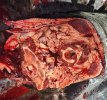
Leg:
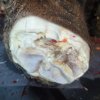
The wakizashi is a weapon that is intended to be able to cut through bone. I'm confident anyone here could take an arm with a single hit because it removed a bovine "arm" rather easily. Someone like Dan or Ben might even be able to cut a person in half with one.
Dry pig bone might be a different story, I'm not familiar with it. The wakizashi is not a "hard use" camping tool, it is designed as a weapon and it performs very well in that application. It might be too thin for something that's very hard and dense.
Nathan the Machinist
KnifeMaker / Machinist / Evil Genius
Moderator
Knifemaker / Craftsman / Service Provider
- Joined
- Feb 13, 2007
- Messages
- 18,299
- Joined
- Dec 16, 2004
- Messages
- 2,018
Dry bone and dry bamboo are both much harder than living examples and may damage an edge.
My understanding is that Katana, Chisa Katana, Wakazashi are all intended for a pull cut or in some cases a push cut.
You are not chopping.
There is somewhat of a sliding motion to the cut. Watch Tamashigeri with rolled mats etc….
There is a reason swords and choppers are differently designed.
My understanding is that Katana, Chisa Katana, Wakazashi are all intended for a pull cut or in some cases a push cut.
You are not chopping.
There is somewhat of a sliding motion to the cut. Watch Tamashigeri with rolled mats etc….
There is a reason swords and choppers are differently designed.
- Joined
- Dec 16, 2004
- Messages
- 2,018
Michael “Tinker” Pearce in discussions and his book THE MEDIEVAL SWORD IN THE MODERN WORLD, talks about center of percussion and related matters. I found it helpful to my understanding.The K20 is not some heavy sword shaped object, it is a real and proper sword.
It is a weapon, I would not use it to process firewood.
That would be like plowing a field with a Ferrari instead of a Lamborghini.
View attachment 2923670View attachment 2923671

